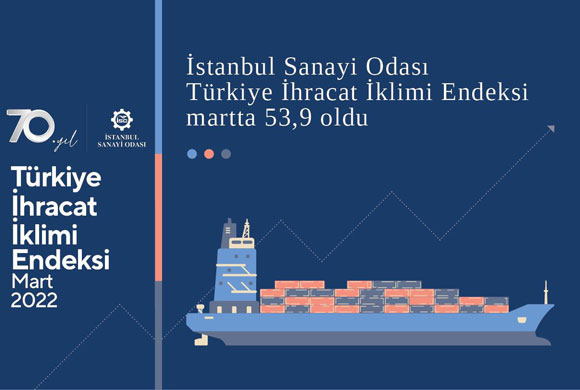ICI Türkiye Export Climate Index for March Released
- 08.04.2022
- News

The Istanbul Chamber of Industry (ICI) Turkish Manufacturing Industry Export Climate Index, which measures the activity conditions of the key export markets of Turkish manufacturing sector, posted 53.9 in March, signaling a solid improvement in the export climate of the manufacturers. It marked the 14th consecutive month of improvement in the export demand. However, the drop of the index, from 55.2 in February indicated a more limited recovery.
Production increase accelerated in some main export markets as disruptions caused by the Covid-19 pandemic relatively eased in March. Growth rates rose to an eight-month high in the United States and a nine-month high in the United Kingdom, and production growth accelerating in France. As a result of the initial effects of the war in Ukraine, however, there was a loss of momentum in the output growth of Germany, Italy, Spain and the Netherlands. In Russia, where production fell sharply, the three-month growth period ended. The non-oil economic activity growth rate in the United Arab Emirates (UAE) maintained its strong level, while the most pronounced deceleration occurred in Hong Kong.
The Istanbul Chamber of Industry (ICI) Türkiye Manufacturing Export Climate Index, which measures the operation conditions in the key export markets of the Turkish manufacturing sector, announced the results of the index for March 2022. In the index, the figures above the 50.0 no-change mark signals an improvement in the export climate, while the figures below signals deterioration.
The Istanbul Chamber of Industry (ICI) Turkish Manufacturing Industry Export Climate Index, which measures the activity conditions of the key export markets of Turkish manufacturing sector, posted 53.9 in March, signalling a solid improvement in the export climate of the manufacturers It marked the 14th consecutive month of improvement in the export demand. However, the drop of the index, from 55.2 in February indicated a more limited recovery.
Strong output growth in the USA, UK and France
Output growth in some of the key export markets has accelerated as disruptions caused by the Covid-19 pandemic relatively eased in March. Economic activity in the US and the UK recorded stronger increases compared to February. Growth rates rose to an eight-month high in the United States and a nine-month high in the United Kingdom. Output growth in France — one of the most important export markets in the eurozone — accelerated in March. But other parts of the region saw deceleration as a result of the initial effects of the war in Ukraine on supply chains and price pressures. There was a loss of momentum in the output growth of Germany, Italy, Spain and the Netherlands. In Russia, where production fell sharply, the three-month growth period ended. Following a thirteen-month growth trend in Poland and a four-month growth trend in the Czech Republic, the output of the manufacturing sector signaled a slight drop.
Growth continues in the Middle East, while in Egypt, the drop accelerated
The non-oil economic activity growth rate in the United Arab Emirates (UAE) maintained its strong level in March and did not indicate a significant change since February. Growth in Qatar also accelerated, the data showed. With the downturn in the Middle East, Egypt saw a 21-month low in output. The most apparent slowdown among the countries monitored in March was in Hong Kong. The restrictions imposed by the severe Covid-19 wave in this country caused widespread production losses. A similar situation occurred in China, though slightly better. Output in this country recorded the sharpest decline of the last two years.
Commenting on the Istanbul Chamber of Industry Türkiye Manufacturing Export Climate Index, Andrew Harker, Economics Director, S&P Global, said:
"Although export demand conditions remained resilient at the end of the first quarter, the large-scale effects of the war in Ukraine, such as loss of business confidence, price increases and supply chain disruptions, have the potential to limit manufacturers’ export opportunities in the second quarter of the year,” Harker said.